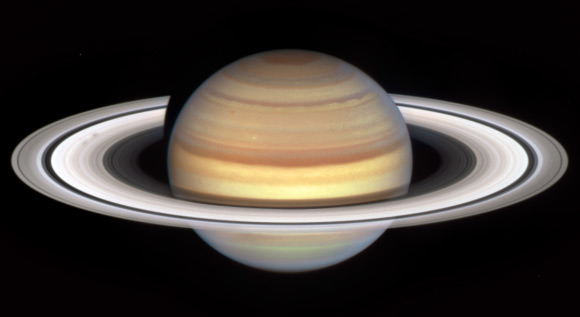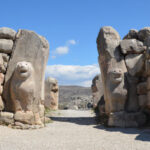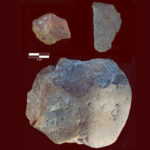Saturn is known for its iconic, pristine rings. However, the main B ring can have splotches and streaks of darker or lighter material, known as spokes, that may be tied to dust interactions with the planet’s magnetic field. These spokes appear periodically, lasting around 8 years, centered around Saturn spring or fall equinox. In 2021 and 2022, observations using the NASA/ESA Hubble Space Telescope revealed the start of a new ring spoke season in advance of the next equinox in 2025. Multi-color observations revealed a reddish color, and that the spokes circle the planet at about the same rate as the ring particles, though perhaps influenced by the variable rotation rate of Saturn’s magnetosphere.
This Hubble image heralds the start of Saturn’s ‘spoke season’ with the appearance of two smudgy spokes in the B ring, on the left in the image. Image credit: NASA / ESA / Amy Simon, NASA’s Goddard Space Flight Center / Alyssa Pagan, STScI.
Like Earth, Saturn is tilted on its axis and therefore has four seasons, though because of Saturn’s much larger orbit, each season lasts approximately seven Earth years.
Equinox occurs when the rings are tilted edge-on to the Sun.
The spokes disappear when it is near summer or winter solstice on Saturn.
When the Sun appears to reach either its highest or lowest latitude in the northern or southern hemisphere of a planet.
As the autumnal equinox of Saturn’s northern hemisphere on May 6, 2025, draws near, the spokes are expected to become increasingly prominent and observable.
The suspected culprit for the spokes is the planet’s variable magnetic field.
Planetary magnetic fields interact with the solar wind, creating an electrically charged environment. On Earth, when those charged particles hit the atmosphere this is visible in the northern hemisphere as the aurora borealis.
Astronomers think that the smallest, dust-sized icy ring particles can become charged as well, which temporarily levitates those particles above the rest of the larger icy particles and boulders in the rings.
The ring spokes were first observed by NASA’s Voyager mission in the early 1980s.
The transient, mysterious features can appear dark or light depending on the illumination and viewing angles.
“Thanks to Hubble’s Outer Planet Atmospheres Legacy (OPAL) program, which is building an archive of data on the outer solar system planets, we will have longer dedicated time to study Saturn’s spokes this season than ever before,” said Dr. Amy Simon, a senior planetary scientist at NASA and head of the Opal program.
Saturn’s last equinox occurred in 2009, while NASA’s Cassini spacecraft was orbiting the gas giant for close-up reconnaissance.
With Cassini’s mission completed in 2017, and Voyager spacecraft long gone, Hubble is continuing the work of long-term monitoring of changes on Saturn and the other outer planets.
“Despite years of excellent observations by the Cassini mission, the precise beginning and duration of the spoke season is still unpredictable, rather like predicting the first storm during hurricane season,” Dr. Simon said.
“While our Solar System’s other three gas giant planets also have ring systems, nothing compares to Saturn’s prominent rings, making them a laboratory for studying spoke phenomena.”
“Whether spokes could or do occur at other ringed planets is currently unknown.”
“It’s a fascinating magic trick of nature we only see on Saturn — for now at least.”
The study was published in the journal Geophysical Research Letters.
_____
Amy A. Simon et al. Hubble Detects the Start of a New Saturn Ring Spoke Season. Geophysical Research Letters, published online February 9, 2023; doi: 10.1029/2022GL101904
This article is based on text provided by the National Aeronautics and Space Administration.




